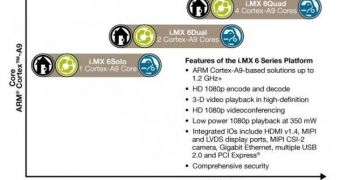Those that believed Qualcomm, NVIDIA and Texas Instruments had only each other to compete against on the market of processors for consumer electronics seem to have been proven wrong, as Freescale has decided to join the fun.
Unlike PCs, consumer electronics rely on processors that can pack as many features as possible.
Where a PC can pack a CPU, a video card, the memory and a bunch of other processors, for the BIOS or whatever else, consumer electronics, especially small ones, like handhelds, need multi-purpose chips for the sake of compactness.
This led to the appearance of so-called ARM-based SoC (system-on-chip) devices, like NVIDIA's Tegra 2, or similar offering from Qualcomm and Texas Instruments.
Now, Freescale has joined this effort with an entire collection of single-core, dual-core and quad-core chips, all part of the i.MX 6 Series.
They have separate 2D and vertex acceleration engines, 3D playback support, 3D graphics of up to 200 MTPS (million triangles per second) and support for stereoscopic image sensor.
There is also mention of 1 MB of L2 cache memory, multi-streaming of 1,080p video and encoding, plus support for Gigabit Ethernet, PCIe, HDMI 1.4, SD3.0, USB 2.0 and SATA 3.0 Gbps.
"Our i.MX 6 series offers consumers the novel and uncompromised online experiences they demand from next-generation connected consumer electronic products," said Bernd Lienhard, vice president and general manager of Freescale’s Multimedia Applications Division.
"Low power, cost efficiency, enormous processing headroom and unmatched compatibility are at the heart of the i.MX 6 series," Lienhard added.
The type of cores featured in the i.MX 6 series are ARM Cortex-A9, each with a clock speed of up to 1.2 GHz.
E-readers, smartphones, tablets and other such things should start to adopt the newcomers as their center piece starting by the end of the ongoing year, 2011. Sample shipments will start to be carried out in the second quarter.

 14 DAY TRIAL //
14 DAY TRIAL //